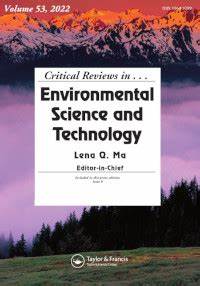Chloroaromatics remediation: Insights into the chemical reduction and hydrodechlorination of chlorobenzenes
IF 13.2
1区 环境科学与生态学
Q1 ENVIRONMENTAL SCIENCES
Critical Reviews in Environmental Science and Technology
Pub Date : 2025-11-02
DOI:10.1080/10643389.2025.2560432
引用次数: 0
Abstract
Chloroaromatic compounds—including not only chlorobenzenes, but alsochloroanilines, chlorophenols and others—are chemicals widely used for decades as industrial solvents, synthetic intermediates, and pesticides. However, many of these compounds are classified as persistent organic pollutants due to their biaccumulative nature, additionally having toxic and neurotoxic effects to humans and animals. Significant stocks of obsolete chloroaromatics, along with numerous heavily contaminated sites worldwide—including air, surface water, groundwater, and soil—underscore the urgent need for efficient remediation strategies. Chemical reduction has emerged as a well-stablished and effective approach for the transformation and/or valorization of chloroaromatics, particularly chlorobenzenes, into less toxic and higher-value compounds, such as cyclohexane and benzene. This approach may also yield other specific products such as methane, polyaromatics, and carbon-based nanomaterials.In this review, we provide the first comprehensive and also critical assessment of all hydrodechlorination and chemical reduction methods applied to the transformation, remediation, and valorization of chlorobenzenes. All the available literature has been analyzed in terms of practical feasibility, limitations, cost-effectiveness, and scalability. Reduction strategies are categorized by the type of reducing agent, distinguishing between stoichiometric and catalytic methods. The performance of various reductants—including metals, metal sulfides, hydrogen gas, hydrides, and water—in combination with a long series of organic and inorganic hydrogen donors (e.g. hydrocarbons, alcohols, formates, silanes, hydrazine) is thoroughly evaluated. Finally, insights into the electrochemical and photochemical reduction of chlorobenzenes in both polluted water and soil are also provided.氯芳烃修复:氯苯的化学还原和加氢脱氯
氯芳香族化合物——不仅包括氯苯,还包括氯苯胺、氯酚等——是几十年来广泛用作工业溶剂、合成中间体和杀虫剂的化学物质。然而,由于其双蓄积性,这些化合物中的许多被归类为持久性有机污染物,另外对人类和动物具有毒性和神经毒性作用。废弃氯芳烃的大量库存,以及世界范围内大量严重污染的场所——包括空气、地表水、地下水和土壤——强调了对有效修复策略的迫切需要。化学还原已成为将氯芳烃,特别是氯苯转化和/或增值为毒性较小和价值较高的化合物,如环己烷和苯的一种行之有效的有效方法。这种方法也可能产生其他特定的产品,如甲烷、多芳烃和碳基纳米材料。在这篇综述中,我们首次对所有用于氯苯转化、修复和增值的加氢脱氯和化学还原方法进行了全面和批判性的评估。所有可用的文献都在实际可行性、局限性、成本效益和可扩展性方面进行了分析。还原策略根据还原剂的类型进行分类,区分化学计量和催化方法。各种还原剂——包括金属、金属硫化物、氢气、氢化物和水——与一系列有机和无机氢供体(如碳氢化合物、醇、甲酸酯、硅烷、肼)结合的性能进行了全面评估。最后,对氯苯在受污染的水和土壤中的电化学和光化学还原也提供了见解。
本文章由计算机程序翻译,如有差异,请以英文原文为准。
求助全文
约1分钟内获得全文
求助全文
来源期刊
CiteScore
27.30
自引率
1.60%
发文量
64
审稿时长
2 months
期刊介绍:
Two of the most pressing global challenges of our era involve understanding and addressing the multitude of environmental problems we face. In order to tackle them effectively, it is essential to devise logical strategies and methods for their control. Critical Reviews in Environmental Science and Technology serves as a valuable international platform for the comprehensive assessment of current knowledge across a wide range of environmental science topics.
Environmental science is a field that encompasses the intricate and fluid interactions between various scientific disciplines. These include earth and agricultural sciences, chemistry, biology, medicine, and engineering. Furthermore, new disciplines such as environmental toxicology and risk assessment have emerged in response to the increasing complexity of environmental challenges.
The purpose of Critical Reviews in Environmental Science and Technology is to provide a space for critical analysis and evaluation of existing knowledge in environmental science. By doing so, it encourages the advancement of our understanding and the development of effective solutions. This journal plays a crucial role in fostering international cooperation and collaboration in addressing the pressing environmental issues of our time.

 求助内容:
求助内容: 应助结果提醒方式:
应助结果提醒方式:


